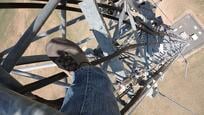Over the years manufactures in the outdoor wireless bridge industry have migrated their designs of radio systems. In the past, most radios used in Point to Point microwave wireless were comprised of radio units that were mounted indoors. These radios hardware platforms required radios that were rack mounted indoors and had to use large coax (1/2" to 2 1/4" Heliax or LMR) or Elliptical Waveguide (requiring dehydrators) running out from the indoor radio unit up the tower (or to the roof top), connecting the antenna.
Because of the large amount of line loss, large cable or waveguide had to be used to compensate for the amount of line loss between the radio and the antenna (typical 6.1dB per 100ft with standard LDF 4-50 1/2" Heliax). To compensate for the line loss larger antennas also needed to be used in conjunction of the larger cable.
The advantages of this type of wireless backhaul radio system is that a technician can walk into a data room/closet or outdoor radio shelter to service the radio or replace it in event of a radio failure. But there are a lot of disadvantages with this set up:
- The larger the cable/waveguide and antennas, the greater the cost of the overall system.
- Less over gain of the radio system due to the line loss.
- Greater infrastructure needed to support the loading of the larger antennas and cabling on the tower and/or mounts.
- Costs with maintaining an in facility.
- These types of radio systems typically have greater power consumption.
- More points of failure to troubleshoot (dehydrators, couplers, cable, etc.)
The industry later came out with a split mount design radio system consisting of an indoor modem unit ("IDU" - typically a 1U rack mounted piece of hardware) and an outdoor RF Unit ("ODU") that mounts the actual radio RF component hardware directly onto the back of the antenna. This system typically uses a smaller IF (intermediate feed) coax cable to pass DC power and the data between the ODU to the IDU. The IF cable can be 1/2" coax or less. The advantages of this type of system are greater system gain (with virtually no loss between the radio and the antenna) and lower costs of system components (less cabling and no need for expensive waveguide or dehydrators). Still many of the same disadvantages still apply with the need for indoor space requirements and costlier power consumption.
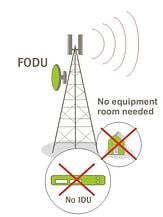
Today the industry has migrated to full outdoor radio unit systems (FODU") comprised of a single outdoor unit mounted to the back of the antenna. These FODU's contain the RF components, modems, and network interface. The connection between the FODU and the network switch is typically outdoor shielded twisted pair (CAT-5e) or fiber. The FODU design has far greater advantages over the indoor radio or IDU+ODU spit mount designs:
- FODU's consume a minimum of 20% less energy (typically use 25W to 30W DC).
- Systems can be powered by solar or battery.
- No equipment room or rack space needed.
- Lower over all OPEX (operational expenditure costs).
- Higher gain to virtually no loss between radio and antenna.
- No cost for expensive coax or waveguide.
- Single component which makes for simple troubleshooting
- Easy to spare equipment.
- Quicker and easier install and maintenance.
- Easy to daisy chain radios at repeater sites or for dual radio set ups (1+1)
The argument that comes up with individuals that are use to the older way systems were designed is the fear of everything being up on the tower and not being able to service it. Most end-users are not tower certified and can't do their own servicing. In roof top applications this is a non-issue but it is true in a tower situation. But even with all indoor radio systems there is still the need for tower services for troubleshooting because the large number of potential points of failure of the system components that reside on the tower (e.g. the coax/waveguide, couplers, connectors, weather proofing, surge protection, antenna, etc.).
Troubleshooting an all indoor system or split mount design can take a lot of labor and have great costs associated to it. For example:
- a bad coupler on waveguide or moisture getting into the waveguide is very difficult and time consuming to identify.
- The same holds true for damaged coax (coax that might have been crushed or dinged during tower work on other existing systems).
- Blown or faulty surge protection.
- Worn or improper weather proofing.





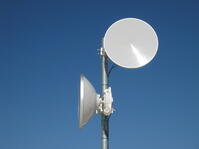
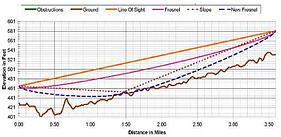
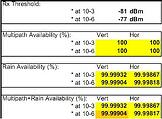
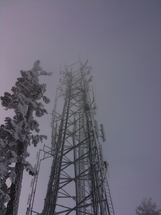 Moisture such as fog, rain, and snow (depending on its water content) adds attenuation to the signal's path. The amount of moisture is critical to understand here. Fog, although dense, has very low moisture when it comes to its effect on RF signal. With snow it all depends on its density. Snow typically has less moisture content than actual rain. Rain depends on the amount of rainfall (measured in mm/h) and the size of the raindrops. Heavier the raindrops and the higher velocity of rainfall the higher the attenuation. Typical rainfall produces roughly 5.5dB. Again it depends on the amount of rain coming down and the frequency being used.
Moisture such as fog, rain, and snow (depending on its water content) adds attenuation to the signal's path. The amount of moisture is critical to understand here. Fog, although dense, has very low moisture when it comes to its effect on RF signal. With snow it all depends on its density. Snow typically has less moisture content than actual rain. Rain depends on the amount of rainfall (measured in mm/h) and the size of the raindrops. Heavier the raindrops and the higher velocity of rainfall the higher the attenuation. Typical rainfall produces roughly 5.5dB. Again it depends on the amount of rain coming down and the frequency being used.